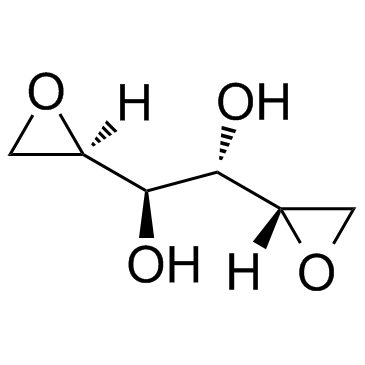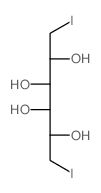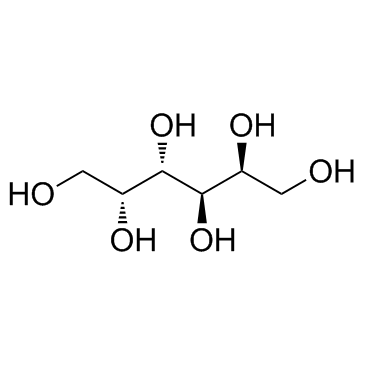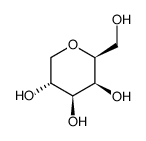23261-20-3
| Name | 1,2-bis(oxiran-2-yl)ethane-1,2-diol |
|---|---|
| Synonyms |
Galactitol,1,2:5,6-dianhydro
1,2:5,6-Diepoxydulcitol Dulcitoldiepoxide 5,6-Diepoxydulcitol Dianhydrogalactitol 1,2,5,6-dianhydro-galactitol 1,2-5,6-dianhydro-dulcitol Dianhydrodulcitol VAL-083 |
| Description | VAL-083 is an alkylating agent that creates N7 methylation on DNA, with antitumor activity. |
|---|---|
| Related Catalog | |
| Target |
DNA Alkylator[1] |
| In Vitro | VAL-083 is an alkylating agent that creates N7 methylation on DNA. VAL-083 suppresses U251 and SF188 cell growth and induces apoptosis after 72 h. VAL-083 (5 μM) inhibits the growth of SF188 by ∼95%. VAL-083 inhibits T98G cells growth in a dose-dependent manner (IC50 <5 μM)[1]. VAL-083 (Dianhydrogalactitol) inhibits the proliferation of HUVEC and U251 cells at doses of more than 12.5 μg/mL. VAL-083 (3.125, 6.25, 12.5 μg/mL) also suppresses the migration and invasion, and reduces MMP2, VEGF, VEGFR2, and FGF2 expression in HUVEC and U251 cells[2]. VAL-083 (1,2:5,6-dianhydrogalactitol, 1, 2, 5 μM) dose-dependently induces cell cycle arrest at G2/M phase in the 3 glioma cell lines. VAL-083 activates two parallel signaling cascades, the p53-p21 and the CDC25C-CDK1 cascade. In addition, VAL-083 significantly enhances the radiosensitivity of LN229 cells[3]. |
| In Vivo | VAL-083 (Dianhydrogalactitol; 25, 50, 100 μg/mL) dose-dependently inhibits angiogenesis in zebrafish model. VAL-083 considerably reduces VEGF, VEGFR2, and FGF2 expression at 25 μg/mL, and further causes reduction in FGFR2 expression at 50 μg/mL[2]. VAL-083 (1,2:5,6-dianhydrogalactitol; 5 mg/kg, iv, twice per week for 6 weeks) significantly blocks the growth of LN229 cells in mice with the relative tumor growth rate (T/C) of 22.38%, and the tumor growth inhibitory rate (TGI) of 83.58%. Moreover, VAL-083 dramatically activates the CDC25C-CDK1 cascade in the xenografted tumor moedl[3]. |
| Cell Assay | The effects of VAL-083 in HUVEC and U251 cellHUVEC and U251 cell proliferation are measured by the CCK8 assay. Cells are seeded into 96-well plates at a destiny of 1 × 104 cells per well. After overnight incubation, cell attachment is followed by the addition of VAL-083 in various concentrations for 24 h; then 10 μL CCK8 is added to each well and incubated at 37°C for 2 h. Optical density is measured at 450 nm[2]. |
| Animal Admin | Mice[3] LN229 cells are suspended in MEM, and 2 × 106 cells per mouse are subcutaneously injected into the flank of BALB/c nude mice at 6-8 weeks old. The tumor volume is calculated as follows: 0.5×L×W2. Tumor-bearing mice are divided into two groups (n = 8) with similar average volumes (vehicle: 108 ± 4 mm3 vs VAL-083: 107 ± 4 mm3). Then, both groups undergo the following treatment: The VAL-083 treatment group receives VAL-083 at 5 mg/kg or 10 μL/g, iv, twice per week for 6 weeks. The vehicle group receives saline at 10 μL/g, iv, three times per week for 6 weeks. Tumor volumes are measured twice per week[3]. |
| References |
| Density | 1.567 |
|---|---|
| Boiling Point | 348ºC at 760mmHg |
| Molecular Formula | C6H10O4 |
| Molecular Weight | 146.14100 |
| Flash Point | 164.3ºC |
| Exact Mass | 146.05800 |
| PSA | 65.52000 |
| Storage condition | 2-8℃ |
CHEMICAL IDENTIFICATION
HEALTH HAZARD DATAACUTE TOXICITY DATA
MUTATION DATA
|
| HS Code | 2910900090 |
|---|
| Precursor 0 | |
|---|---|
| DownStream 3 | |
| HS Code | 2910900090 |
|---|---|
| Summary | 2910900090. epoxides, epoxyalcohols, epoxyphenols and epoxyethers, with a three-membered ring, and their halogenated, sulphonated, nitrated or nitrosated derivatives. VAT:17.0%. Tax rebate rate:13.0%. . MFN tariff:5.5%. General tariff:30.0% |



